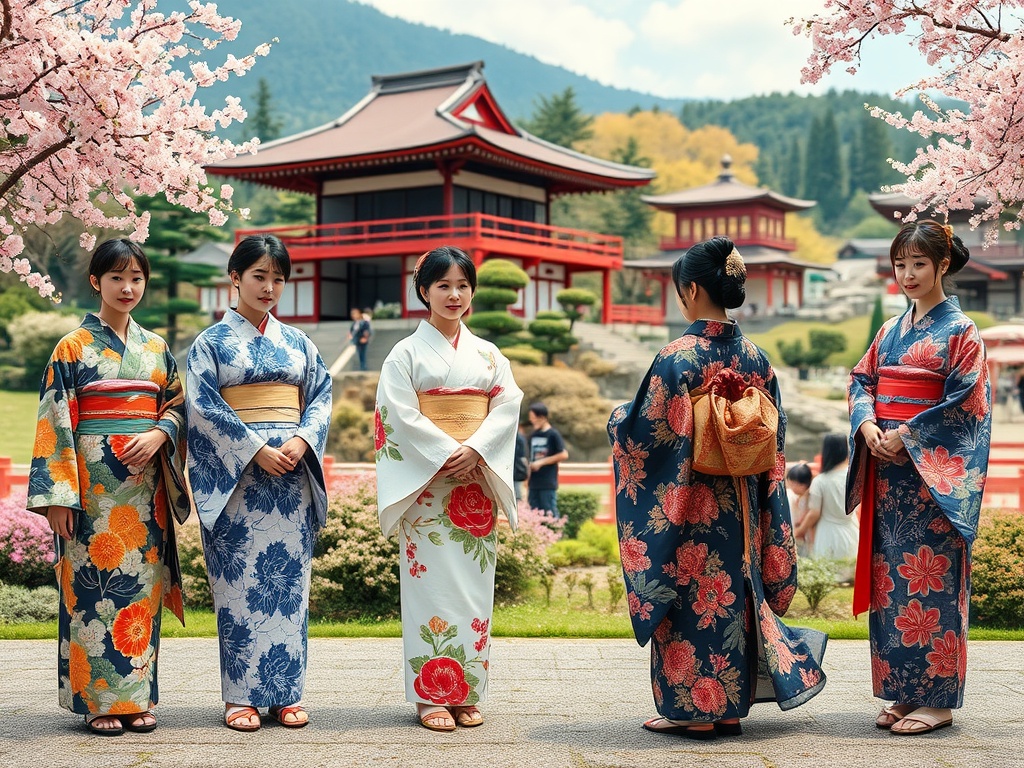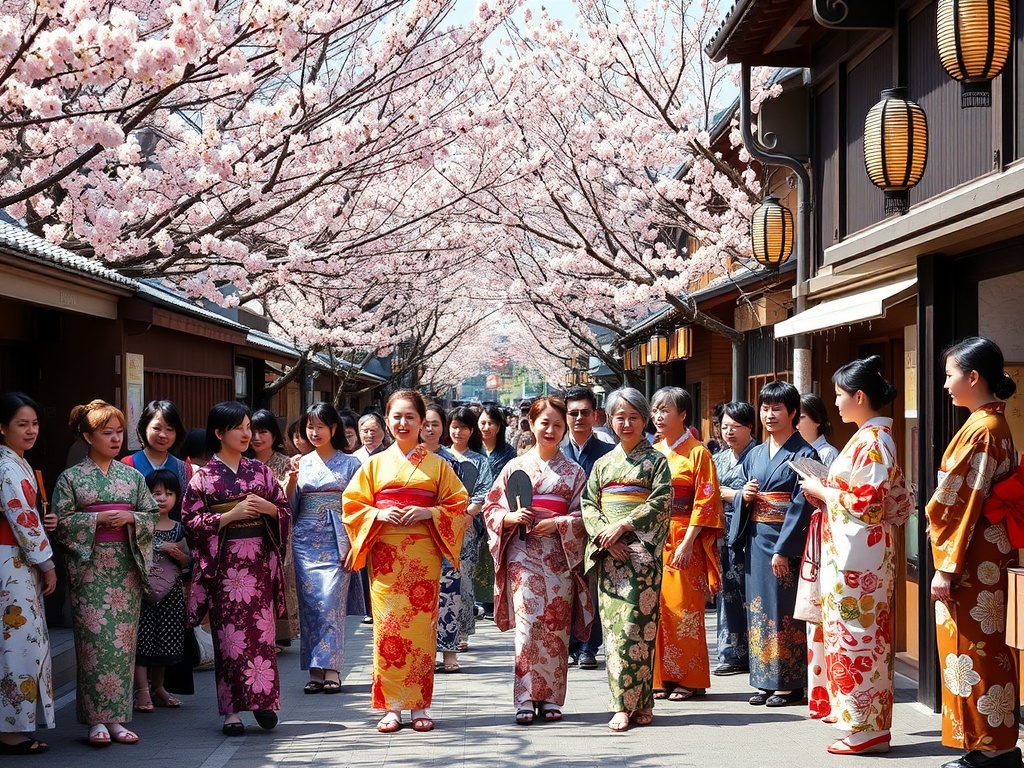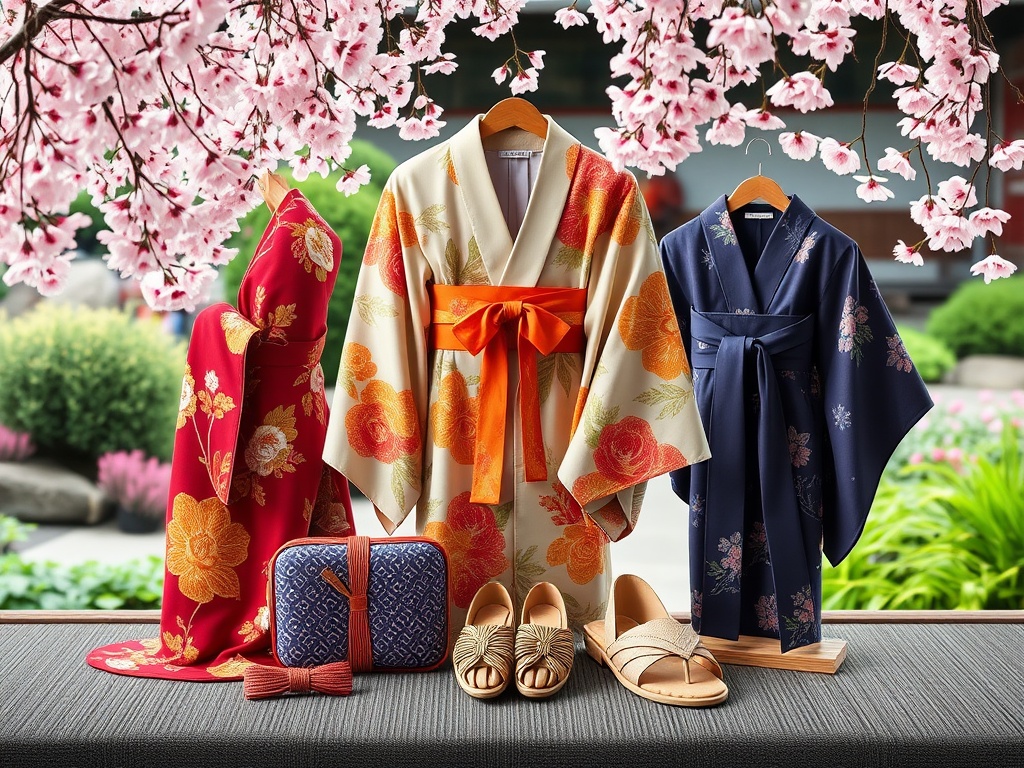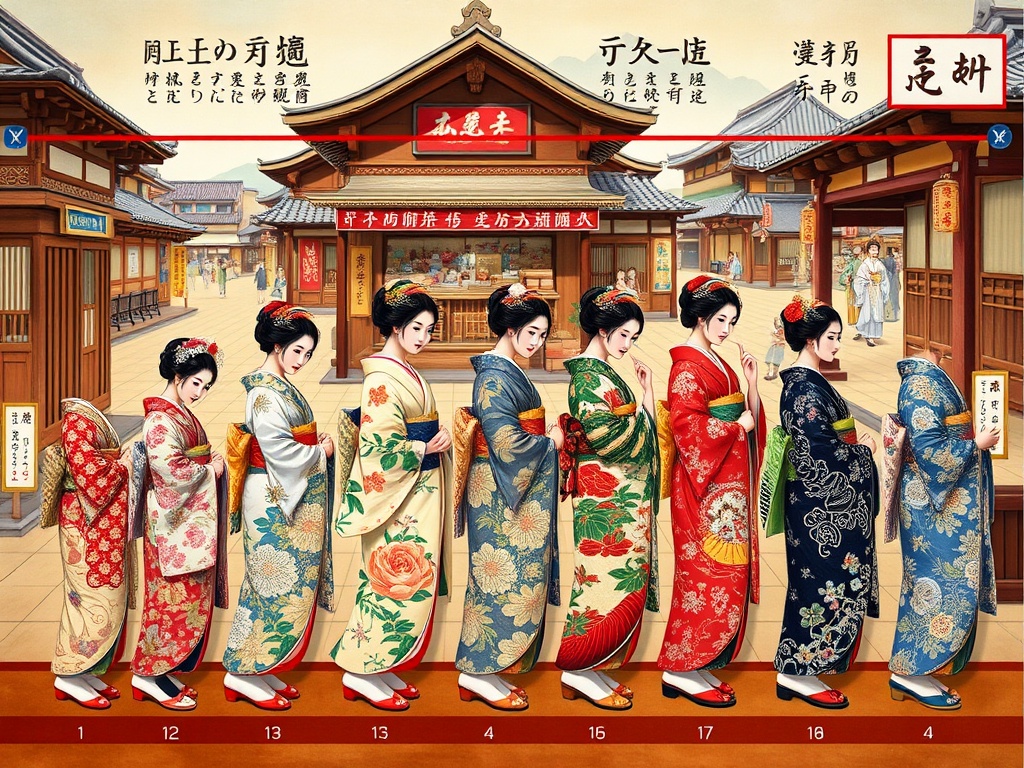The Art of Wearing: A Journey Through Kimono Styles and Occasions

Win a Free Trip to Japan!
Experience cherry blossoms and ancient temples
The kimono, a symbol of Japanese culture, is more than just a garment—it’s an exquisite art form that tells stories of tradition, craftsmanship, and individuality. As you explore the vibrant streets of Japan, you’ll notice the kimono’s beautiful presence at weddings, festivals, and tea ceremonies, each occasion highlighting a unique style and flair. This guide will unravel the mystery behind kimono styles and the occasions that bring them to life, inviting you into a world where fabric dances with history.
The world of kimono is vast and varied, with each style crafted for specific moments and meanings. Whether you’re a traveler planning to partake in a traditional event or a curious soul eager to understand the cultural nuances, these primary kimono styles will captivate your imagination:
- Furisode: Known for its long, flowing sleeves, the Furisode is the most formal kimono for unmarried women, often worn at coming-of-age ceremonies and weddings.
- Yukata: A casual, lightweight kimono usually crafted from cotton, worn during summer festivals and perfect for hot weather.
- Houmongi: A semi-formal kimono for married and unmarried women, ideal for social gatherings, featuring elegant and continuous patterns.
- Montsuki: A formal men’s kimono, typically black with a family crest, often seen at weddings and other ceremonial occasions.
- Iromuji: A versatile single-colored kimono without a pattern, suitable for both formal and informal events, worn by women.
Kimono wearing is an art deeply intertwined with Japanese customs, and each occasion calls for a specific style. Understanding when and where to wear a kimono enhances the experience, offering a glimpse into the cultural significance of each event:
Weddings: At traditional Japanese weddings, the bride may wear a Shiromuku—a pure white kimono symbolizing purity—while guests might don formal Kurotomesode or Montsuki.
Tea Ceremonies: These serene gatherings usually call for understated elegance, with guests wearing Iromuji or Komon to blend simplicity with grace.
Festivals: The vibrant atmosphere of summer festivals invites the cheerful Yukata, allowing wearers to enjoy the festivities with comfort and style.
From Obi to Zori: Discover the Intricate World of Kimono Accessories
Delve into the enchanting realm of kimono accessories, where every piece holds a story and purpose, enhancing the timeless beauty of traditional Japanese attire. The art of wearing a kimono is incomplete without understanding its intricate accessories, each contributing to the overall aesthetic and cultural expression. For travel and tourism enthusiasts, exploring these accessories offers a deeper appreciation of Japan’s rich heritage and craftsmanship. Let’s embark on a journey to uncover the elegance and functionality of these essential components.
Accessorizing the kimono is an art that requires precision and an understanding of traditional Japanese aesthetics. Each accessory serves a specific function and adds layers of meaning to the ensemble. Below is a list of essential kimono accessories that highlight the detailed artistry involved in this cultural attire:
- Obi: A broad sash worn around the waist, the obi is the centerpiece of the kimono ensemble, available in various styles and designs, often elaborately decorated to suit specific occasions.
- Obiage: This is a small piece of fabric that is tucked into the top of the obi, adding a splash of color and helping to hold the knot in place.
- Obijime: A decorative cord tied around the obi, providing both a practical function to secure the obi and a decorative element.
- Geta and Zori: Traditional Japanese footwear worn with the kimono. Geta are wooden sandals often worn with casual yukata, while zori are more formal sandals typically paired with formal kimono.
- Tabi: Traditional split-toe socks worn with geta or zori, adding comfort and completing the look of the kimono ensemble.
Accessories in the kimono world are not merely decorative; they play a vital role in signifying social status, marital status, and even the wearer’s mood or the season. For instance, the color and design of an obi can transform the mood of the kimono, while the choice of obiage and obijime can subtly convey seasonal changes. Understanding the nuances of these accessories provides a window into Japanese culture, where aesthetics and symbolism intertwine. For travelers, witnessing or participating in the art of accessorizing a kimono is a memorable experience, rich with tradition and beauty.
Cultural Chronicles: The Historical Evolution of Traditional Japanese Attire
The journey through the history of traditional Japanese attire is like unfurling a tapestry woven with the threads of time. Each layer showcases a unique era, reflecting the dynamic societal changes and artistic influences that have shaped Japan’s sartorial landscape. From the regal robes of the Heian period to the minimalist elegance of contemporary fashion, traditional Japanese clothing encapsulates a rich heritage that continues to captivate travel and tourism enthusiasts worldwide. This exploration offers a window into the past, where every garment tells a story of its own.
The Heian period (794-1185) marked a golden age for Japanese culture, where aristocrats adorned themselves in the vibrant and multilayered jūnihitoe, a ceremonial kimono ensemble that demonstrated the wearer’s rank and sophistication. This era was characterized by an explosion of textile artistry, with intricate patterns and rich colors symbolizing both personal status and the changing seasons. The jūnihitoe was not merely clothing; it was an expression of the wearer’s identity and an embodiment of the cultural ethos of the time.
During the Edo period (1603-1868), the kimono became more accessible to the general populace, blossoming into a significant cultural symbol. This era witnessed the rise of the ukiyo-e woodblock prints, which often depicted everyday life and fashion, immortalizing the kimono’s evolving styles. As societal norms shifted, so did the kimono, embracing more practical designs that catered to the burgeoning merchant class. The Edo period’s kimono culture was a harmonious blend of tradition and modernity, with an enduring influence that resonates in contemporary Japanese fashion.
Beyond the Kimono: Unveiling the Secrets of Traditional Japanese Garments
While the kimono elegantly represents the heart of traditional Japanese fashion, a world of other garments awaits your discovery, each with its own story and cultural significance. For travel and tourism enthusiasts, venturing beyond the kimono opens a treasure trove of historical narratives and artistic expression, offering a deeper understanding of Japan’s sartorial tapestry.
The Hakama: Known for its wide-legged trousers, the hakama is often worn over a kimono, creating a distinctive and formal silhouette. Traditionally donned by samurai, today it graces martial arts practitioners and is a staple in ceremonies like graduation events. The hakama’s design and color often signify the occasion’s solemnity, making it an intriguing garment for those exploring Japanese cultural events.
Jinbei: In contrast, the jinbei provides a glimpse into Japan’s casual attire. Typically worn during summer, this two-piece outfit is favored for its comfort and breathability. Crafted from lightweight cotton or hemp, the jinbei is a popular choice for festivals or lounging at home, offering a relaxed yet culturally rich experience for travelers.
For those interested in seasonal attire, the Haori presents a captivating option. Originally a men’s jacket, it has evolved into a versatile garment for both genders. The haori is typically worn over a kimono, adding an extra layer of warmth and style. With intricate patterns and vibrant colors, it embodies a fusion of tradition and personal expression, particularly during the cherry blossom season.
The exploration of these garments reveals the diverse expressions of Japanese culture through clothing, extending beyond the iconic kimono. Each piece not only serves a functional purpose but also weaves into the fabric of Japan’s rich heritage, inviting you to delve into a world where every garment tells a tale of tradition, artistry, and innovation.
Seasonal Splendor: How Nature Inspires the Colors and Patterns of Kimono
In the realm of traditional Japanese clothing, the kimono reigns as a timeless symbol of cultural elegance. However, its beauty extends beyond the fabric and craftsmanship; it captures the essence of nature’s cyclical transformation. For travel and tourism enthusiasts, understanding how the seasons influence kimono colors and patterns offers a profound appreciation of Japan’s artistic sensibilities. This section explores the vibrant interplay between nature and kimono design, inviting you to witness a tapestry where fabric whispers the secrets of the seasons.
The colors of a kimono are not chosen at random; they reflect the hues of the natural world as it shifts from one season to another. This deep connection to nature is a defining characteristic of Japanese aesthetics, where each season brings its own palette to life:
- Spring: The gentle blush of cherry blossoms and the fresh greens of new growth inspire pastel shades and floral motifs, embodying renewal and hope.
- Summer: Bright, vibrant colors dominate, mirroring the lively festivals and abundant sunshine. Bold blues and reds, often featuring water motifs, reflect the season’s energetic spirit.
- Autumn: As leaves turn to rich reds and golds, kimonos reflect these warm tones, often adorned with motifs like maple leaves and chrysanthemums, symbolizing change and harvest.
- Winter: The subdued elegance of winter is captured in deep blues, whites, and silvers, often decorated with snowflake or pine motifs, representing purity and endurance.
Beyond color, the patterns woven into kimono fabrics carry symbolic meanings, often linked to nature and the seasons. These motifs are more than decorative; they convey stories and cultural values, enriching the wearer’s experience and connection to Japan’s heritage:
- Cherry Blossoms (Sakura): A quintessential spring motif symbolizing the transient beauty of life.
- Crane (Tsuru): Often seen in winter kimonos, representing longevity and good fortune.
- Bamboo (Take): A symbol of resilience and strength, frequently used in summer designs.
- Wave (Nami): Emblematic of power and persistence, it is a popular summer motif reflecting the dynamic energy of the ocean.
Kimono Craftsmanship: Meet the Artisans Behind Japan’s Timeless Fashion
For those captivated by the allure of traditional Japanese clothing, understanding the intricate craftsmanship behind each kimono is a journey into the heart of Japan’s cultural artistry. The kimono is not merely a piece of clothing; it is a canvas where skilled artisans weave stories of heritage, beauty, and innovation. As you delve into this fascinating realm, you’ll discover the dedication and passion of the artisans who breathe life into these exquisite garments.
At the core of kimono craftsmanship lies the art of weaving, a meticulous process that begins with the selection of the finest silk threads. Artisans, often from families with generations of experience, skillfully create intricate patterns that embody cultural narratives and seasonal beauty. Each weaver brings a unique touch to their work, ensuring that every kimono tells a distinct story.
- Description of Weaving Techniques:
- Nishijin-ori: Originating from Kyoto, this technique uses gold and silver threads to produce luxurious, shimmering patterns.
- Kasuri: Known for its blurred patterns, this method involves dyeing threads before weaving, creating a sense of depth and movement.
- Yūzen: A dyeing technique that uses resist dyeing to create vibrant, detailed designs, often depicting scenes from nature.
Once woven, the kimono fabric undergoes a transformative dyeing process, where skilled artisans use natural dyes to infuse the fabric with color and pattern. This stage is crucial, as the choice of colors and motifs must harmonize with the fabric’s texture and the wearer’s intention. The dedication of dyeing artisans is evident in the precision of their craft, where even a single brushstroke can alter the garment’s entire character.
The dyeing process is not just about aesthetics; it’s a cultural expression that reflects Japan’s deep connection with nature. Artisans often draw inspiration from seasonal changes, ensuring that each kimono resonates with the natural world.
The journey from thread to kimono culminates in the hands of the tailor, who meticulously constructs the garment. This final stage demands not only technical skill but also an understanding of the kimono’s cultural significance. Tailors must balance traditional techniques with modern influences, creating a garment that is both timeless and contemporary.
For travel and tourism enthusiasts, visiting workshops and studios where these artisans work offers a unique glimpse into the world of kimono craftsmanship. It is an opportunity to witness firsthand the passion and dedication that go into creating Japan’s most iconic fashion statement, a testament to the enduring legacy of traditional Japanese clothing.
Dressing the Part: The Role of Kimono in Japanese Festivals and Ceremonies
Immerse yourself in the vibrant world of Japanese festivals and ceremonies, where the kimono becomes more than attire; it transforms into a powerful symbol of cultural celebration and personal expression. Whether you’re exploring the bustling streets during a summer matsuri or attending a serene tea ceremony, the kimono’s presence is both a visual and emotional centerpiece, embodying the spirit of the occasion.
Festivals in Japan are a kaleidoscope of color and energy, and wearing a kimono is a cherished tradition that connects participants to their cultural roots. During summer festivals, the Yukata—a lighter, more casual version of the kimono—takes center stage. Its vibrant patterns and breathable fabric allow wearers to enjoy festivities with ease, symbolizing a fusion of tradition and modern comfort. For travelers, donning a yukata offers a unique opportunity to engage with local customs and experience the joy of cultural immersion.
In winter, as the air fills with the aroma of street food and the sound of festival music, the kimono’s role shifts to one of warmth and elegance. Winter festivals see the use of heavier fabrics and more subdued colors, reflecting the season’s tranquil beauty. The kimono, in these settings, is not just clothing but a canvas of seasonal storytelling, where each stitch and hue narrates the harmony between humans and nature.
The kimono’s role extends beyond festivals, stepping gracefully into the solemnity of Japanese ceremonies. In weddings, the kimono transforms into a majestic attire that marks the sanctity of the union. The Shiromuku, a pure white kimono worn by brides, is a testament to purity and new beginnings. Guests, often in Kurotomesode or Montsuki, uphold the formal atmosphere, their attire resonating with the day’s profound significance.
Tea ceremonies, in contrast, are intimate gatherings where the kimono embraces simplicity and elegance. Participants often wear Iromuji or Komon, reflecting the understated grace that defines these occasions. Here, the kimono’s subtle patterns and soft colors invite calmness and focus, enhancing the ceremony’s meditative nature. For visitors, witnessing or participating in a tea ceremony while dressed in a kimono offers a deeper appreciation of the intricate balance between aesthetics and spirituality in Japanese culture.
Whether it’s the vibrant celebration of festivals or the solemnity of ceremonies, the kimono plays an integral role in Japanese cultural expression. For travel and tourism enthusiasts, experiencing these traditions while dressed in a kimono offers a profound connection to the heart of Japan’s cultural heritage.
Modern Marvels: How Contemporary Designers are Reviving Traditional Japanese Clothing
In a world where fashion continually evolves, the traditional Japanese kimono stands as a testament to timeless elegance and cultural richness. However, the modern era has breathed new life into these age-old garments, as contemporary designers infuse their creations with innovative touches that captivate both traditionalists and trendsetters. For travel and tourism enthusiasts, this modern resurgence of traditional Japanese clothing offers a fresh perspective on Japan’s sartorial landscape, blending the past with the present in a harmonious dance of style and heritage.
Today’s designers are reimagining the kimono, introducing bold patterns, vibrant colors, and unconventional materials that elevate this classic attire into the realm of high fashion. By integrating modern design elements, they preserve the essence of the kimono while making it relevant for contemporary audiences. Tourists visiting Japan can witness firsthand how these updated kimonos are worn in urban settings, showcasing a blend of traditional craftsmanship and modern flair. This fusion not only maintains the cultural significance of the kimono but also invites a global audience to appreciate its beauty in a new light.
The revival of traditional Japanese clothing is more than a fashion statement; it is a cultural renaissance that celebrates Japan’s rich heritage. Designers are drawing inspiration from historical motifs and techniques, such as the intricate Nishijin-ori weaving and delicate Yūzen dyeing, to create garments that honor the past while embracing the future. Visitors to Japan’s fashion districts can explore boutiques and ateliers where these modern marvels are crafted, offering a unique shopping experience that connects them with the artistry of Japanese fashion. This intersection of tradition and innovation invites travelers to immerse themselves in a world where each garment tells a story of cultural pride and artistic evolution.


